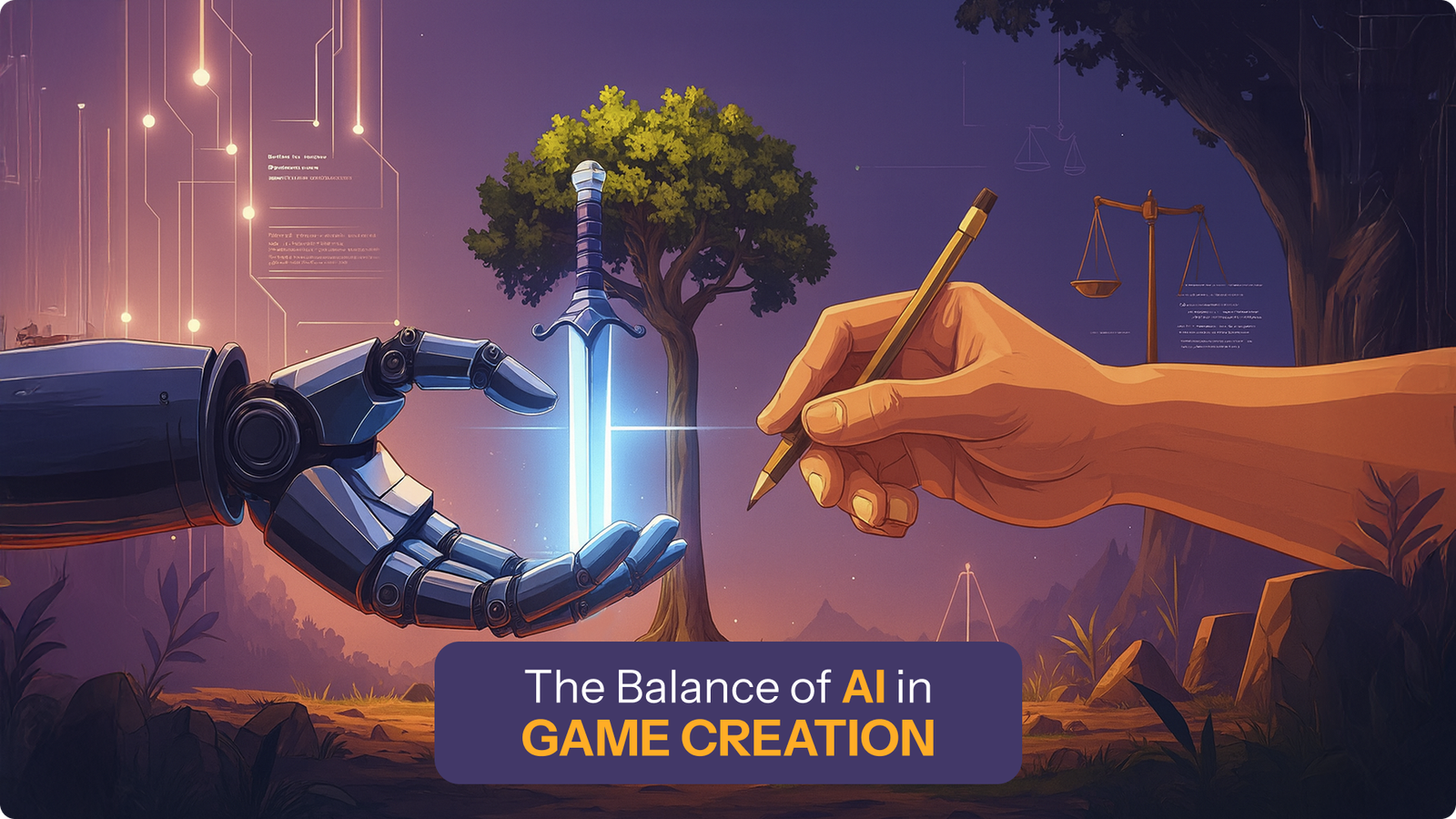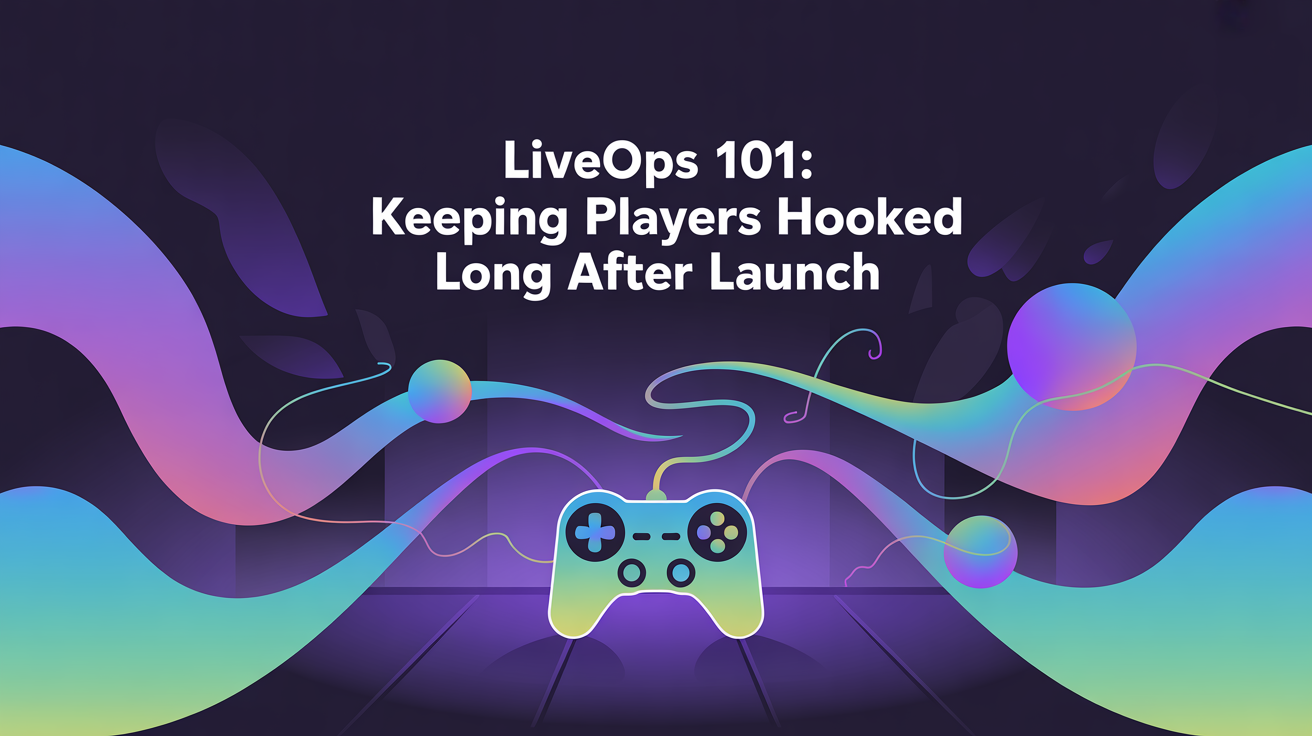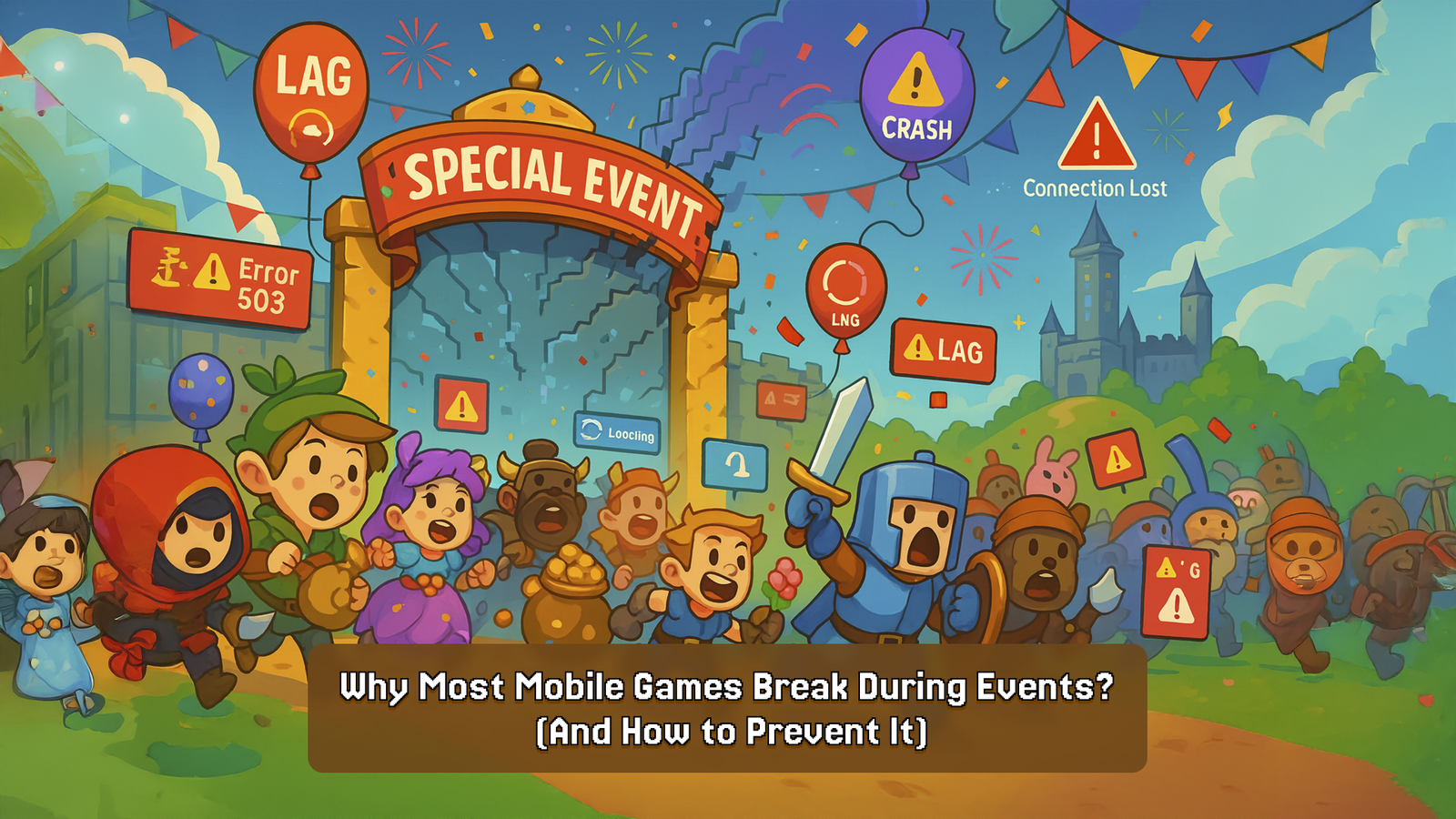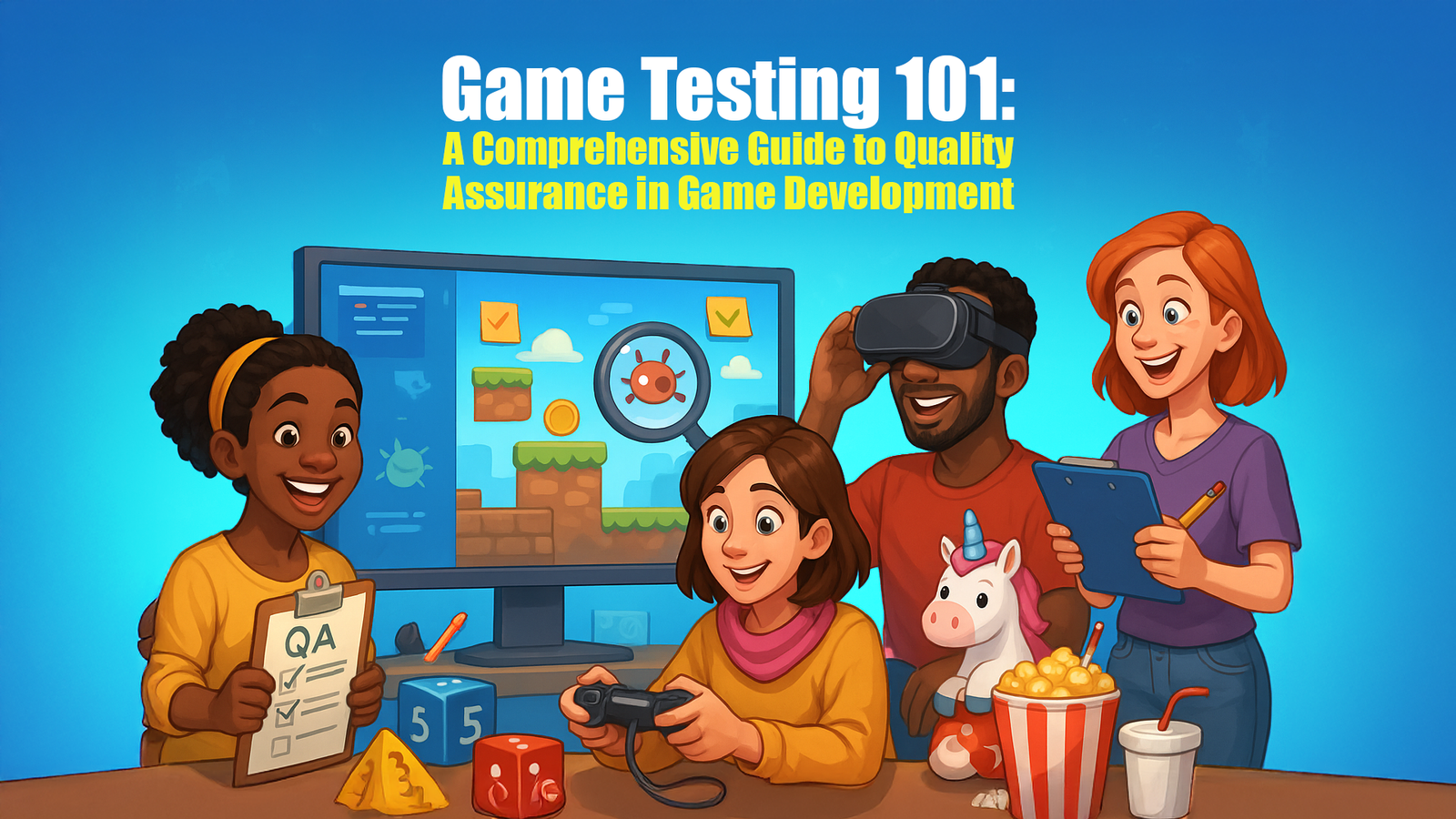Deconstructing Royal Match: What Makes the Game a Multi-Billion Dollar Global Hit?
Deconstructing Royal Match: What Makes the Game a Multi-Billion Dollar Global Hit?
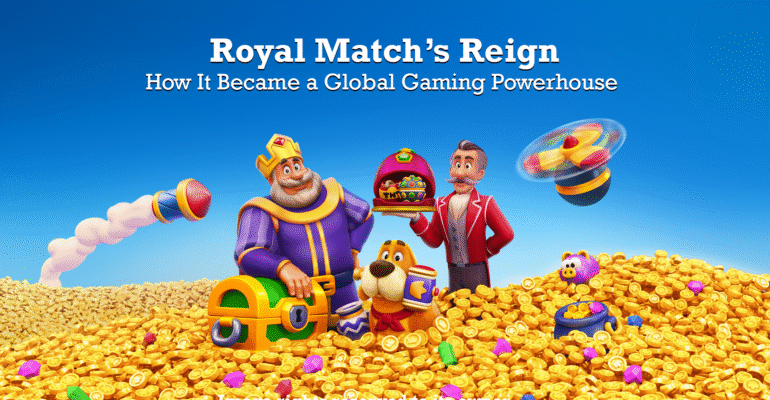
Contents
- 1 Mechanics and Gameplay that Keep Players Wanting More
- 2 Building Rapid Awareness through Aggressive Marketing
- 3 Monetization Strategies that Don’t Break the Experience
- 4 LiveOps that Sustain Long-Term Engagement
- 5 The Bottom Line: Success Not by Chance but Design
- 6 Power Your Game’s Success Strategy with Xpress Gaming
Developed by Dream Games, Royal Match quickly became one of the highest-grossing mobile games of all time. Since its global launch in early 2021, Dream Games’ Royal Match has exceeded 300 million downloads and generated over $3 billion in lifetime gross revenue. In 2024 alone, the game pulled in $1.4 billion, outpacing many industry leaders.
Wondering what makes Royal Match so popular? Or how does Royal Match keep players engaged? Despite the gaming market being flooded with other match-3 puzzle games, Royal Match’s success story in this highly competitive genre is anything but accidental. The credit for its sustained success goes to its carefully curated design, data, and strategy, which made a seemingly casual mobile game scale for millions of players.
Beyond clever mechanics, it’s the synergy between user acquisition, monetization, and long-term player engagement that drives such outcomes. This blog examines the Royal Match success factors in-depth. With a detailed breakdown of its gameplay, marketing tactics, monetization, and LiveOps strategy, let’s explore how the game achieved long-term relevancy and success.
Mechanics and Gameplay that Keep Players Wanting More
This section presents the analysis of Royal Match gameplay and design, describing how each element is carefully crafted to increase engagement, promote retention, and deliver satisfaction across every level of play.
1. Simple Yet Addictive Core Loop
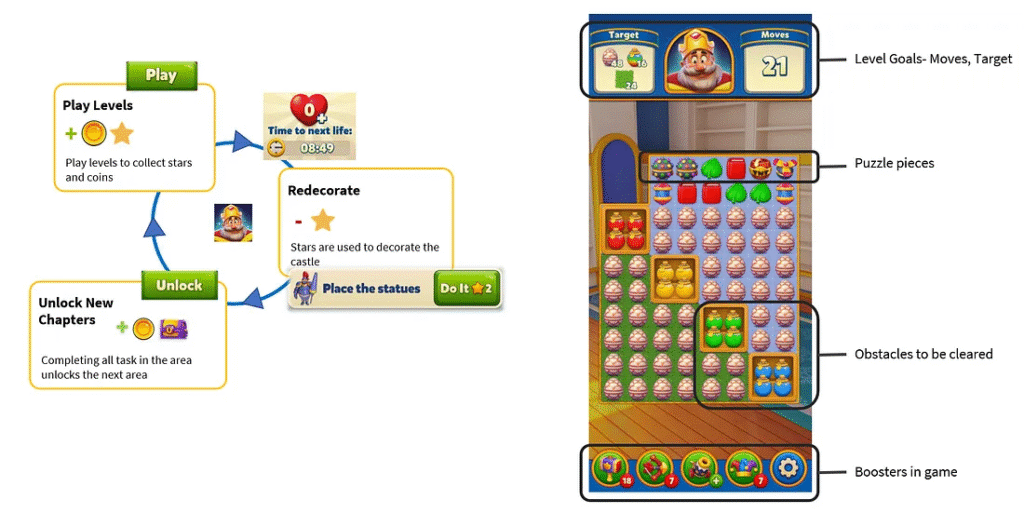
Source: Medium
It’s the core game loop that hooks the player from the start. Royal Match has a reputation for attracting new players at scale. The game’s core loop is built on the foundation of match-3 mechanics, which the players find very intuitive. As a popular genre, the learning curve has low friction that’s instantly familiar to most players. The game offers a brief tutorial that demonstrates how to play the game without interrupting the game’s natural rhythm.
This accessibility plays a major role in widening the game’s reach across age groups and regions. Each level is designed intentionally to last between 1 to 5 minutes, making it perfect for quick sessions during commutes or work breaks. Its bite-sized format encourages repeat play without fatigue.
2. Layered Progression System via Castle Restoration

Source: Lifewire
Beyond just clearing stages, the importance of having a game storyline cannot be underestimated. Royal Match also features a secondary progression layer through castle restoration. The stars earned by the players from the puzzle levels can be used to unlock and decorate various parts of the castle. Many of the game’s ads feature “rescue the king”, which is completely different from the actual gameplay but draws curiosity and clicks.
This adds a layer of variety to its gameplay and keeps the visual environment from feeling repetitive. It unfolds gradually, where the players can restore different areas and progress to different stages, like from the throne room to the garden, and then to the dining room. The mix of primary and secondary gameplay makes the progression feel dynamic and enhances immersion.
3. Smart Difficulty Adjustments to Retain Players’ Interest
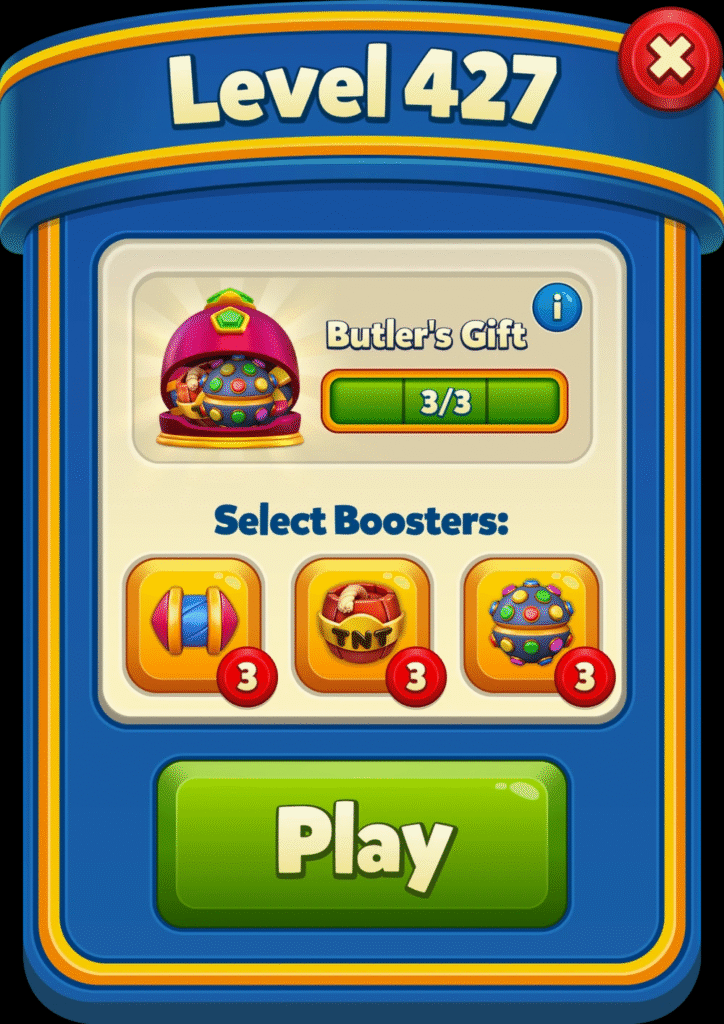
Source: Royal Match Wiki
A game that is too easy can make the players lose interest, while too much difficulty may cause frustration. Royal Match’s smart difficulty pacing keeps the players engaged without overwhelming or underwhelming them. The early levels are intentionally easy for quick wins to build initial confidence, while gradually gaining momentum and intensifying as the game progresses.
So, after the first few stages, the challenge increases gradually with new tile types, obstacles, and level objectives. The game also introduces boosters and power-ups at the right moments to help players when they are stuck on tougher levels. This balance between challenge and support plays a key role in reducing early churn and retaining players’ interest.
4. The Master Stroke with Super Light Ball
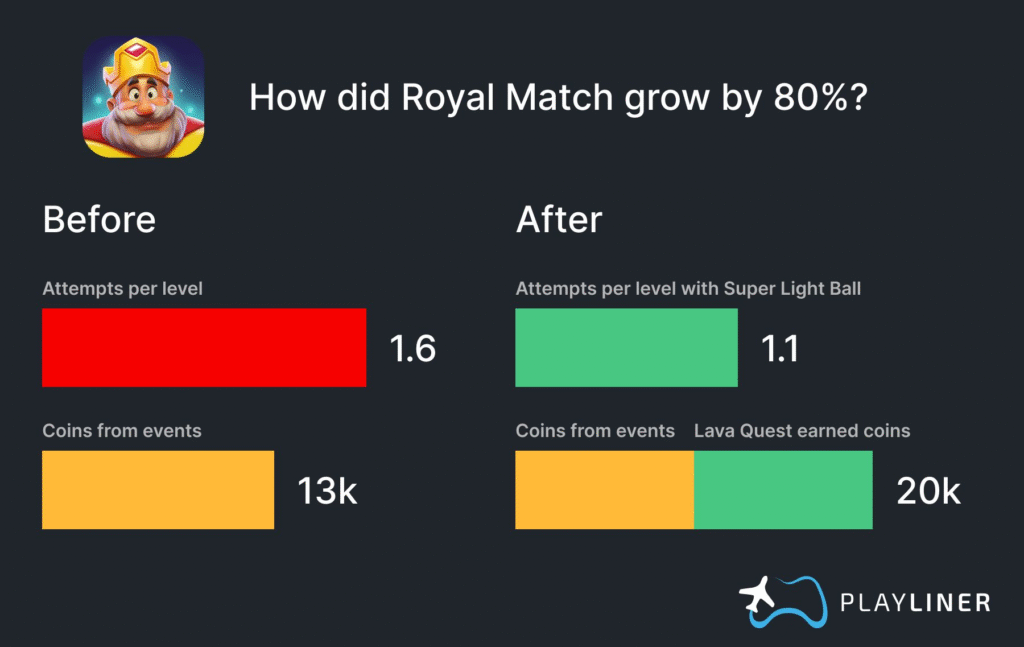
Source: Playliner
With the Super Light Ball booster, Royal Match introduced a game changer that reshaped how players approached level progression and strategy. Players can earn the booster by matching five or more tiles, which can be used to clear large sections on the board in a single move.
Since its launch, players began reporting extended win streaks with it, with some claiming they went months without losing a level. As a result, their engagement soared along with in-game spending. The feature alone drove a 1.5x spike in revenue, marking it a key feature.
Royal Match game mechanics were quickly adopted by other developers to make successful match-3 puzzle games. For instance, Matchington Mansion and Lily’s Garden introduced similar mechanics, cementing the Super Light Ball as a genre standard. The success of this feature illustrates how a seemingly simple feature can significantly improve gameplay dynamics and commercial outcomes.
Building Rapid Awareness through Aggressive Marketing
From dominating app store keywords to flooding ads on social platforms, the game consistently appeared in front of its target audience. This section explores how strategic marketing helped Royal Match scale so rapidly.
1. User Acquisition Campaigns
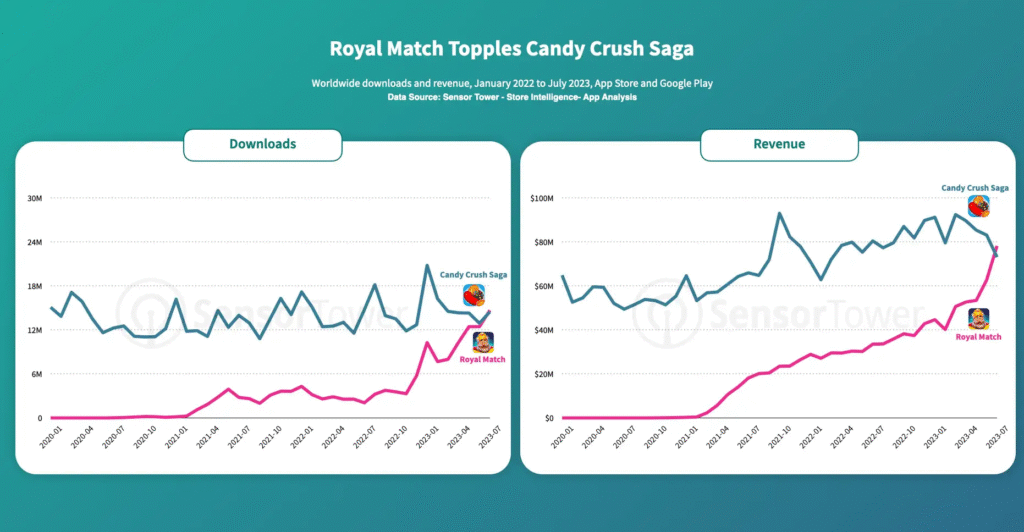
Source: Sensor Town
Royal Match’s growth to success isn’t all organic; behind its massive awareness lies a meticulously executed user acquisition campaign. The game has built a reputation for its aggressive marketing, dominating search results for top-performing keywords like “puzzle games” across the US App Store.
According to a PocketGamer report, 61.5% of its installs come from paid downloads. It is nearly three times higher than Candy Crush’s 15-25%, and well above the standard industry benchmark. Credit goes to its data-backed bidding strategies and creative ad optimization that fueled its scalable reach.
2. Cross-promotion and Influencer Tie-ins

Source: ESPORTS
The aggressive marketing strategy of Royal Match extends to celebrity endorsements and cross-channel promotion. Popular figures like Simon Cowell, Tom Felton, and Kate Flannery have endorsed the game to widen its appeal across different audience segments. Beyond just virality and recognition, these influencer tie-ins are carefully timed and platform-specific.
While the game falls under the casual gaming category, the marketers made sure the visual identity followed high standards. It is hard to miss their ads on leading social media platforms like YouTube, Instagram, and TikTok.
3. Brand Personality and Consistency
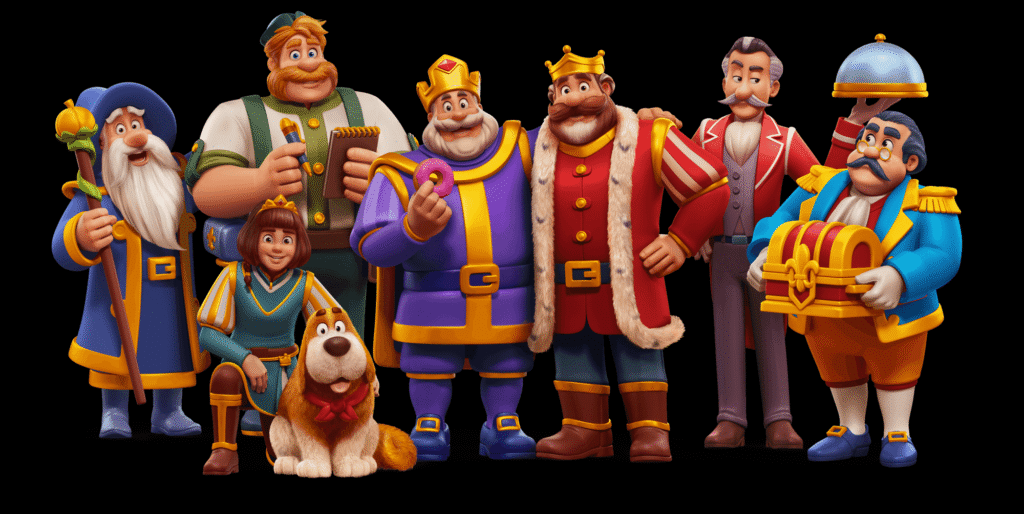
Source: Dream Games
Royal Match’s brand identity is built around its main character, King Robert, who is a friendly figure driving both game visuals and marketing. The game stands out with a cohesive brand personality that keeps the visuals bright, cheerful, and distinctly regal.
From the game’s visuals to its marketing campaigns, it uses consistent fonts, brand color schemes, and animations to ensure quick recognition. Additionally, their high-production budget TV ads helped the game build a strong and high-standard visual identity. Beyond visuals, every ad script of the game is consistent with the King’s quirky charm that a wide variety of audiences find attractive.
Monetization Strategies that Don’t Break the Experience
As part of this Royal Match game analysis, understanding the game’s revenue model reveals why it’s one of the most successful titles in the match-3 genre. Discover how its business model and emotional design cues drive spending without disrupting the core loop:
1. Free-to-Play with Strategic In-App Purchases
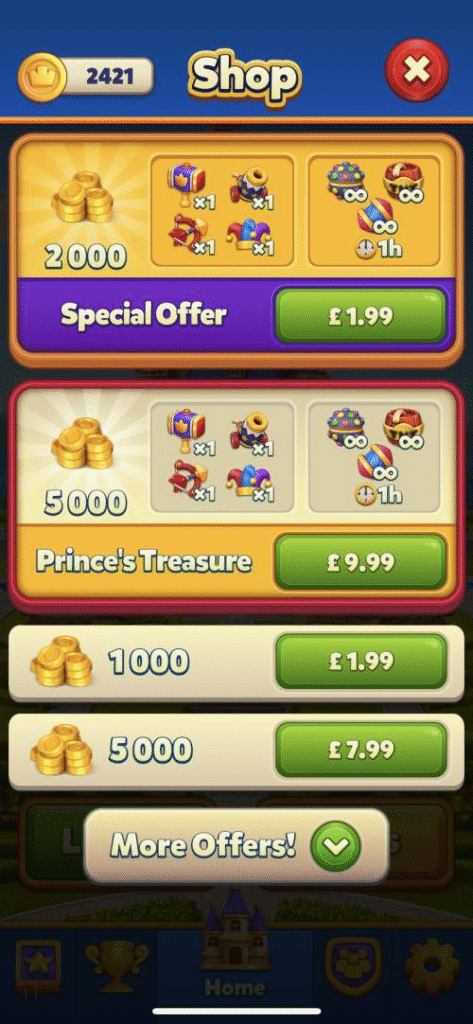
Source: Game UI Database
Why is Royal Match successful in monetization? It’s because it has a free-to-play model that doesn’t cap energy or life and offers unlimited playtime. This model boosts their engagement as well as increases the window for monetization. When players are stuck on any level, they can purchase boosters, extra moves, and coin bundles to move forward without worrying about depleting energy or life.
By January 22, 2025, the game surpassed $5 billion in revenue through direct user spending on in-app purchases. With longer engagement, Dream Games was able to capitalize on a consistent in-game economy based on coins, which users spend directly to progress through the game.
Unlike the titles with ad-based monetization, the Royal Match monetization strategy ensures uninterrupted gameplay and offers optional purchases to provide freedom of choice. This strategy demonstrates that a frictionless experience, coupled with well-timed purchase options, can generate massive revenue without forcing it.
2. Monetization Through Emotional Drivers

Source: Game Refinery
Royal Match’s monetization strategy doesn’t rely solely on functional utility. By tapping into emotional decision-making like FOMO (fear of missing out) and frustration-based triggers, they turned everyday gameplay moments into monetization opportunities with high conversion rates.
Offers like extra moves and boosters are presented as limited-time decisions when players face difficult levels or narrowly miss objectives. This creates a sense of urgency to act before progress is lost and drives repeated in-app purchases, primarily through FOMO. Flash deals and personalized bundles also appear after failed attempts, which monetizes micro-defeats without disrupting the flow.
Their monetization strategy through emotional drivers was further amplified by seasonal events and time-limited challenges. This is particularly effective during holidays or when players are deep into progression arcs. Offers like special power-ups or “event-only” bundles are made accessible only for a few hours or limited days. This drives impulse purchases through perceived scarcity.
3. Personalized Offers and Player Segmentation
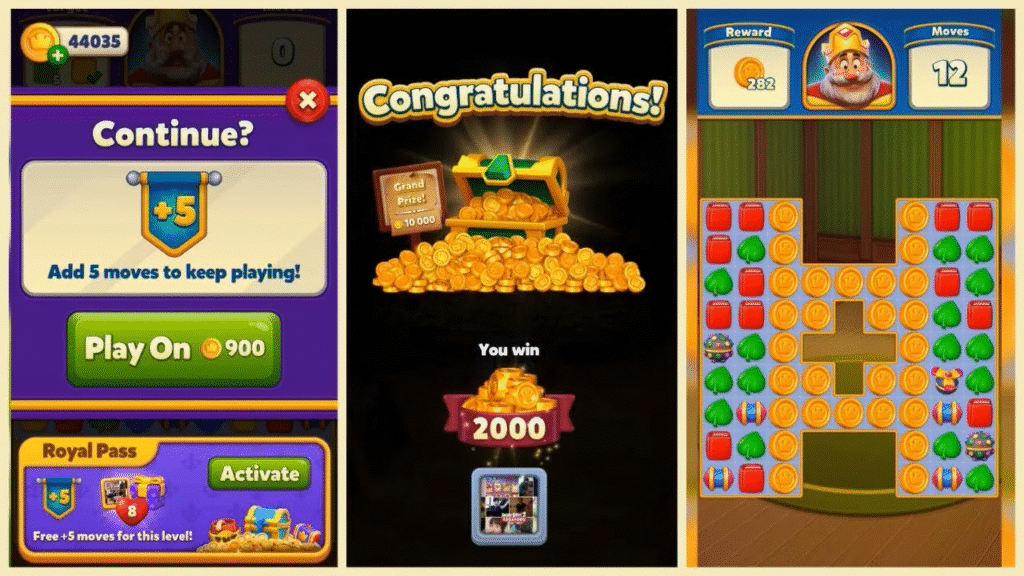
Source: Fox Data
Royal Match tailors its offers to individual player behavior, a seemingly simple yet vital strategy to drive more conversions. Rather than using one-size-fits-all pricing, the game understands its players by analyzing how they interact with levels, how often they fail, and their spending habits, which are used to optimize bundles and pricing strategies.
A struggling player will get different deals than those who can clear stages easily. For instance, low-spending users may receive steeper discounts or personalized bundles with multiple items, while players who are more likely to spend get offers like premium packs with rare boosters or coins.
By segmenting players based on their skill and spending habits, the game increases conversion rates and also avoids fatigue caused by offers they are less likely to opt for. Due to their relevancy and time of presentation during the gameplay, players develop a perception of seeing them as a part of the experience.
LiveOps that Sustain Long-Term Engagement
Royal Match’s long-term success is driven by a robust LiveOps strategy that keeps players consistently engaged. This section explores how the game used LiveOps to encourage players to return, compete, and invest across extended play cycles.
1. Regular Content Updates

Source: Game Refinery
Royal Match LiveOps strategy follows an aggressive content schedule that helps maintain its momentum. As of 2025, the game has more than 9,500 levels, with new levels released every two weeks. This way, the game always has something fresh to offer for long-time players.
This cadence extends beyond puzzles. The secondary gameplay of castle restoration expands to new rooms and themed environments with the game’s progress, which the players find visually stimulating. With a mix of indoor and outdoor settings, the game never feels monotonous.
Additionally, seasonal events like “Summer Pass” and “Hidden Temple” further deepen engagement and make the dormant players return to unlock rare content or complete special missions. This steady stream of content keeps the ecosystem alive and extends player lifecycles.
2. Social Play and Team Mechanics

Source: Games
Royal Match user retention is strongly supported by social play and team mechanics. Though designed to be lightweight, they are quite effective in keeping the gameplay loop simple and approachable by all. Players can join teams to share lives, participate in team-based events, and climb collective leaderboards, fostering community-driven retention.
Royal Match includes a team feature where players can request free lives from teammates, and up to five members can respond to each request. Since players rely on teammates for lives or bonuses, this gives them more reasons to return collectively and stay active. Further, team competitions and rewards also make wins feel shared rather than isolated.
The dynamic is reminiscent of what worked well in titles like Project Makeover for driving community engagement. But in Royal Match, it’s tightly integrated with LiveOps cycles. Team-based competitions are synced with limited-time events, and rewards from team events align with ongoing seasonal content.
3. Re-engagement with Push Notifications
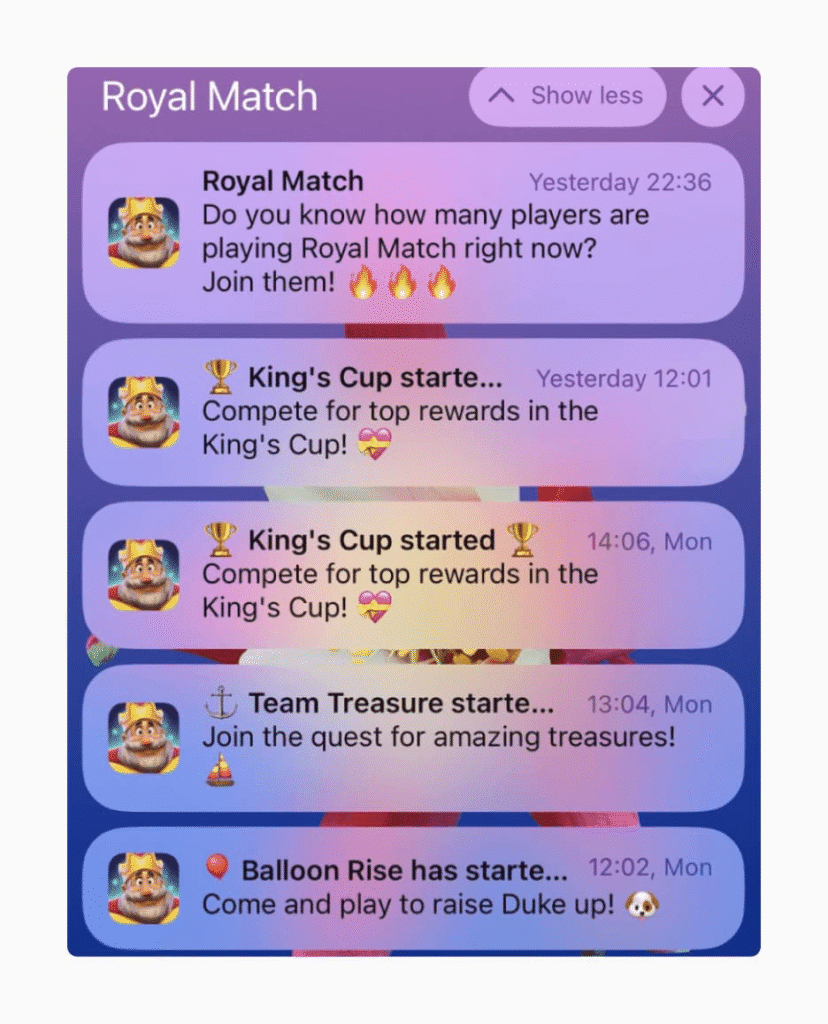
Source: App Growth Blog
Through targeted push notifications, Royal Match reconnects players when they’re most receptive. With timed reminders for new levels and seasonal events, they encourage prompt re-entry to the game and enhance long-term engagement. This reinforced the core goals of LiveOps: fluid engagement, revived dormant users, and event participation, all without needing an update.
These alerts aren’t pushed randomly; they are based on behavior-based segmentation that ensures they are aligned with player behaviors. For instance, alerting a player who has not engaged for a week or notifying about limited-time events during campaigns. Demonstrating Royal Match’s success in mastering push notification strategies.
The Bottom Line: Success Not by Chance but Design
In an overcrowded match-3 market, Royal Match carved its own space and continues to succeed. Behind its sustained success lies meticulous design, strategic marketing, and a long-term LiveOps vision. The blog presented an in-depth discussion on the four key pillars of success: mechanics, marketing, liveOps, and monetization.
For game makers, this Royal Match deconstruction serves as a guide to make these pillars work in their favor and drive engagement, monetization, and growth at scale. The key insights into Royal Match game success:
- Royal Match’s design and game mechanics feature a frictionless core loop with short, easy-to-play levels and intuitive visuals.
- The game’s layered progression systems combine gameplay with visual storytelling to create a sense of accomplishment, variety, and narrative depth.
- The Super Light Ball booster is a game changer that significantly increased both retention and revenue by enabling longer win streaks.
- The game uses aggressive but targeted user acquisition strategies, paired with a strong brand identity.
- The game demonstrated smart monetization through emotional triggers, personalized offers, and zero ad disruption.
- A consistent LiveOps framework delivers fresh content and social mechanics that make the game feel new and encourage re-engagement.
With Royal Match’s example as a case study, this blog presented the match-3 game deconstruction, reflecting their natural evolution from simple puzzle mechanics to layered gameplay. For developers looking to build or scale a casual mobile game, it teaches how the blend of creativity and business thinking leads to massive and long-sustained success.
Power Your Game’s Success Strategy with Xpress Gaming
We specialize in building high-performance mobile games backed by experience and results. With 17+ years of experience and 125+ successful mobile titles, we are equipped with both technical depth and creative agility to transform your game vision into reality. Whether you need a fast prototype or a long-term LiveOps partner, we offer customized game development services at competitive prices that align with your business goals.
Contact us today to let our experts blend game design with monetization and transform your game into an immersive experience that engages and retains users.
Client Testimonials Blog ID - 16580
At Kuriosity QA, we are committed to providing the highest quality gaming QA services to our clients in the gaming industry. Here’s what some of our satisfied clients have to say about working with us:
